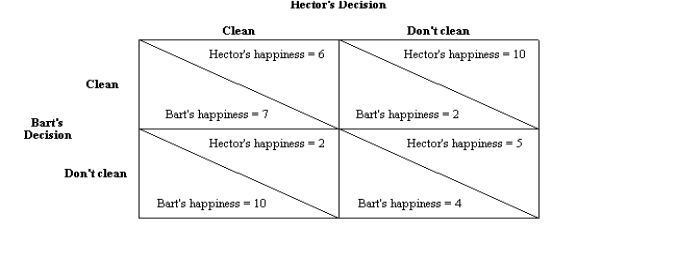A) a competitive equilibrium.
B) an open-market solution.
C) a socially-optimal solution.
D) a Nash equilibrium.
F) C) and D)
Correct Answer

verified
Correct Answer
verified
True/False
Cartels with a small number of firms have a greater probability of reaching the monopoly outcome than do cartels with a larger number of firms.
B) False
Correct Answer

verified
Correct Answer
verified
Multiple Choice
In the game in which two oil companies own adjacent oil fields, the companies will not use the oil efficiently because
A) neither company has a dominant strategy in the game.
B) the companies collude and produce a quantity of oil that is less than the socially-efficient quantity.
C) the pool from which they recover the oil is a common resource.
D) the pool from which they recover the oil is not large enough to allow both companies to earn a positive profit.
F) B) and C)
Correct Answer

verified
Correct Answer
verified
Multiple Choice
George and Jerry are competitors in a local market. Each is trying to decide if it is better to advertise on TV, on radio, or not at all. If they both advertise on TV, each will earn a profit of $3,000. If they both advertise on radio, each will earn a profit of $5,000. If neither advertises at all, each will earn a profit of $10,000. If one advertises on TV and the other advertises on radio, then the one advertising on TV will earn $4,000 and the other will earn $2,000. If one advertises on TV and the other does not advertise, then the one advertising on TV will earn $8,000 and the other will earn $5,000. If one advertises on radio and the other does not advertise, then the one advertising on radio will earn $9,000 and the other will earn $6,000. If both follow their dominant strategy, then George will
A) advertise on TV and earn $3,000.
B) advertise on radio and earn $5,000.
C) advertise on TV and earn $8,000.
D) not advertise and earn $10,000.
F) A) and B)
Correct Answer

verified
Correct Answer
verified
Multiple Choice
Table 17-24
Two firms are considering going out of business and selling their assets. Each considers what happens if the other goes out of business. The payoff matrix below shows the net gain or loss to each firm.  -Refer to Table 17-24. Which firms have a dominant strategy?
-Refer to Table 17-24. Which firms have a dominant strategy?
A) A and B
B) Neither A nor B
C) A but not B
D) B but not A
F) C) and D)
Correct Answer

verified
Correct Answer
verified
True/False
A tit-for-tat strategy, in a repeated game, is one in which a player starts by cooperating and then does whatever the other player did last time.
B) False
Correct Answer

verified
Correct Answer
verified
Multiple Choice
As the number of firms in an oligopoly market
A) decreases, the price charged by firms likely decreases.
B) decreases, the market approaches the competitive market outcome.
C) increases, the market approaches the competitive market outcome.
D) increases, the market approaches the monopoly outcome.
F) C) and D)
Correct Answer

verified
Correct Answer
verified
Multiple Choice
Table 17-1
Imagine a small town in which only two residents, Rochelle and Alec, own wells that produce safe drinking water. Each week Rochelle and Alec work together to decide how many gallons of water to pump. They bring the water to town and sell it at whatever price the market will bear. To keep things simple, suppose that Rochelle and Alec can pump as much water as they want without cost so that the marginal cost of water equals zero. The weekly town demand schedule and total revenue schedule for water is shown in the table below:  21.
-Refer to Table 17-1. If Rochelle and Alec operate as a profit-maximizing monopoly in the market for water, how many gallons of water will be produced and sold?
21.
-Refer to Table 17-1. If Rochelle and Alec operate as a profit-maximizing monopoly in the market for water, how many gallons of water will be produced and sold?
A) 0
B) 500
C) 600
D) 1,200
F) B) and D)
Correct Answer

verified
Correct Answer
verified
Multiple Choice
Figure 17-3. Hector and Bart are roommates. On a particular day, their apartment needs to be cleaned. Each person has to decide whether to take part in cleaning. At the end of the day, either the apartment will be completely clean (if one or both roommates take part in cleaning) , or it will remain dirty (if neither roommate cleans) . With happiness measured on a scale of 1 (very unhappy) to 10 (very happy) , the possible outcomes are as follows:  -Refer to Figure 17-3. If this game is played only once, then the most likely outcome is that
-Refer to Figure 17-3. If this game is played only once, then the most likely outcome is that
A) Hector and Bart both clean.
B) Hector cleans and Bart does not clean.
C) Bart cleans and Hector does not clean.
D) neither Hector nor Bart cleans.
F) B) and C)
Correct Answer

verified
Correct Answer
verified
Multiple Choice
Table 17-12
The table shows the town of Driveaway's demand schedule for gasoline. Assume the town's gasoline seller(s) incurs a cost of $2 for each gallon sold, with no fixed cost.  -Refer to Table 17-12. Suppose we observe that the price of a gallon of gasoline in Driveaway is $2. Given this observation, which of the following scenarios is most likely?
-Refer to Table 17-12. Suppose we observe that the price of a gallon of gasoline in Driveaway is $2. Given this observation, which of the following scenarios is most likely?
A) There is one seller of gasoline in Driveaway.
B) There are two sellers of gasoline in Driveaway.
C) There are a few sellers of gasoline in Driveaway, but the number of sellers exceeds two.
D) There are many sellers of gasoline in Driveaway.
F) A) and B)
Correct Answer

verified
Correct Answer
verified
Multiple Choice
Table 17-21
The Chicken Game is named for a contest in which drivers test their courage by driving straight at each other. John and Paul have a common interest to avoid crashing into each other, but they also have a personal, competing interest to not turn first to demonstrate their courage to those observing the contest. The payoff table for this situation is provided below. The payoffs are shown as (John, Paul) .  -Refer to Table 17-21. If Paul chooses Drive Straight, what will John choose to do and what will John's payoff equal?
-Refer to Table 17-21. If Paul chooses Drive Straight, what will John choose to do and what will John's payoff equal?
A) Turn, 5
B) Drive Straight, 0
C) Turn, 20
D) Drive Straight, 5
F) A) and C)
Correct Answer

verified
Correct Answer
verified
Multiple Choice
Table 17-20
Nadia and Maddie are two college roommates who both prefer a clean common space in their dorm room, but neither enjoys cleaning. The roommates must each make a decision to either clean or not clean the dorm room's common space. The payoff table for this situation is provided below, where the higher a player's payoff number, the better off that player is. The payoffs in each cell are shown as (payoff for Nadia, payoff for Maddie) .  -Refer to Table 17-20. What is Nadia's dominant strategy?
-Refer to Table 17-20. What is Nadia's dominant strategy?
A) Nadia has no dominant strategy.
B) Nadia should always choose Clean.
C) Nadia should always choose Don't Clean.
D) Nadia has two dominant strategies, Clean and Don't Clean, depending on the choice Maddie makes.
F) B) and C)
Correct Answer

verified
Correct Answer
verified
Multiple Choice
If an oligopolist is part of a cartel that is collectively producing the monopoly level of output, then that oligopolist has the incentive to increase production with the aim of
A) increasing prices.
B) increasing profits for the group of firms as a whole.
C) increasing profits for itself, regardless of the impact on profits for the group of firms as a whole.
D) decreasing costs of production.
F) None of the above
Correct Answer

verified
Correct Answer
verified
Multiple Choice
Scenario 17-3.
Consider two countries, Kinglandia and Rovinastan, that are engaged in an arms race. Each country must decide whether to build new weapons or to disarm existing weapons. Each country prefers to have more arms than the other because a large arsenal gives it more influence in world affairs. But each country also prefers to live in a world safe from the other country's weapons. The following table shows the possible outcomes for each decision combination. The numbers in each cell represent the country's ranking of the outcome (10 = best outcome, 1 = worst outcome) .  -Refer to Scenario 17-3. If each country only makes a choice of whether to build or disarm one time and Rovinastan chooses to build new weapons, then Kinglandia will
-Refer to Scenario 17-3. If each country only makes a choice of whether to build or disarm one time and Rovinastan chooses to build new weapons, then Kinglandia will
A) disarm to signal its willingness to cooperate.
B) disarm to promote world peace.
C) build new weapons to prevent the loss of influence in world affairs.
D) None of the above are correct.
F) B) and D)
Correct Answer

verified
Correct Answer
verified
Multiple Choice
Table 17-29
Suppose that two firms, Wild Willy's Wonderdrink (Firm W) and Hyper Hank's Hydration (Firm H) , comprise the market for energy drinks. Each firm determines that it could lower its costs and increase its profits if both firms reduced their advertising budgets. But for the plan to work, each firm must agree to refrain from advertising. Each firm believes that advertising works by increasing the demand for the firm's energy drinks, but each firm also believes that if neither firm advertises, the cost savings will outweigh the lost sales. The table below lists each firm's individual profits:
Firm W
Breaks agreement Maintains agreement
and advertises and does not advertise  -Refer to Table 17-29 Does either Firm W or Firm H have a dominant strategy?
-Refer to Table 17-29 Does either Firm W or Firm H have a dominant strategy?
A) Both Firm W and Firm H have a dominant strategy.
B) Neither Firm W nor Firm H has a dominant strategy.
C) Firm W has a dominant strategy, but Firm H does not.
D) Firm W does not have a dominant strategy, but Firm H does.
F) A) and B)
Correct Answer

verified
Correct Answer
verified
Multiple Choice
Table 17-24
Two firms are considering going out of business and selling their assets. Each considers what happens if the other goes out of business. The payoff matrix below shows the net gain or loss to each firm.  -Refer to Table 17-24. Which firm's dominant strategy is to sell?
-Refer to Table 17-24. Which firm's dominant strategy is to sell?
A) firm A's and firm B's
B) firm A's but not firm B's
C) firm B's but not firm A's
D) neither firm A's nor firm B's
F) C) and D)
Correct Answer

verified
Correct Answer
verified
Multiple Choice
The practice of requiring someone to buy two or more items together, rather than separately, is called
A) resale maintenance.
B) product fixing.
C) tying.
D) free-riding.
F) A) and B)
Correct Answer

verified
Correct Answer
verified
Multiple Choice
Table 17-6
Imagine a small town in which only two residents, Kunal and Naj, own wells that produce safe drinking water. Each week Kunal and Naj work together to decide how many gallons of water to pump, to bring the water to town, and to sell it at whatever price the market will bear. Assume Kunal and Naj can pump as much water as they want without cost so that the marginal cost of water equals zero.
The weekly town demand schedule and total revenue schedule for water are shown in the table below.  -Refer to Table 17-6. Suppose the town enacts new antitrust laws that prohibit Kunal and Naj from operating as a monopolist. Once the Nash equilibrium is reached, how much profit will each producer earn?
-Refer to Table 17-6. Suppose the town enacts new antitrust laws that prohibit Kunal and Naj from operating as a monopolist. Once the Nash equilibrium is reached, how much profit will each producer earn?
A) $400.00
B) $437.50
C) $450.00
D) $800.00
F) A) and B)
Correct Answer

verified
Correct Answer
verified
Multiple Choice
Table 17-24
Two firms are considering going out of business and selling their assets. Each considers what happens if the other goes out of business. The payoff matrix below shows the net gain or loss to each firm.  -Refer to Table 17-24. What is the Nash equilibrium?
-Refer to Table 17-24. What is the Nash equilibrium?
A) A and B both stay in business
B) A stays in business, B sells
C) B stays in business, A sells
D) Both A and B sell
F) A) and B)
Correct Answer

verified
Correct Answer
verified
Multiple Choice
Table 17-2
Imagine a small town in which only two residents, Abby and Brad, own wells that produce safe drinking water. Each week Abby and Brad work together to decide how many gallons of water to pump. They bring water to town and sell it at whatever price the market will bear. To keep things simple, suppose that Abby and Brad can pump as much water as they want without cost so that the marginal cost is zero. The weekly town demand schedule and total revenue schedule for water is shown in the table below:  -Refer to Table 17-2. Suppose the town enacts new antitrust laws that prohibit Abby and Brad from operating as a monopoly. What will be the price of water once Abby and Brad reach a Nash equilibrium?
-Refer to Table 17-2. Suppose the town enacts new antitrust laws that prohibit Abby and Brad from operating as a monopoly. What will be the price of water once Abby and Brad reach a Nash equilibrium?
A) $12
B) $8
C) $6
D) $4
F) None of the above
Correct Answer

verified
Correct Answer
verified
Showing 361 - 380 of 488
Related Exams